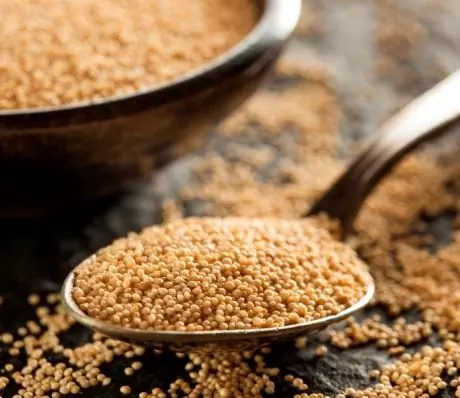- Author Rachel Wainwright [email protected].
- Public 2023-12-15 07:39.
- Last modified 2025-11-02 20:14.
Platyphyllin
Instructions for use:
- 1. Composition and form of release
- 2. Pharmacological action
- 3. Indications for use
- 4. Contraindications to use
- 5. Method of administration and dosage
- 6. Side effects
- 7. Overdose
- 8. Interaction with other medicinal products
- 9. Special instructions
Prices in online pharmacies:
from 137 rubles.
Buy

Platyphyllin is a pharmacological drug from the group of m-anticholinergics, which has an antispasmodic and mild sedative effect.
Composition and form of release
According to the instructions, Platyphyllin is available in ampoules as a solution for parenteral administration. In 1 ampoule 1 ml of 0.2% drug (2 mg of platyphyllin and water for injection).
Externally, Platyphyllin is a colorless, odorless, transparent liquid.
This drug is produced in 10 ampoules in a cardboard box, instructions for use, an ampoule knife or a scarifier are also attached. If the package contains ampoules with dots or rings for opening, then the ampoule knife is not inserted.
Pharmacological action of Platyphyllin
According to the instructions, Platyphyllin is a blocker of m-cholinergic receptors and has an antispasmodic effect on the smooth muscles of the digestive tract and bronchi, and also has a weak sedative (sedative) effect. This drug reduces the secretion of the bronchial, salivary, lacrimal and sweat glands. In addition, Platyphyllin is able to dilate the pupil and cause moderate paralysis of accommodation. This drug may increase intraocular pressure.
Indications for use
The indications for Platyphyllin are the following conditions:
- spastic pains of the digestive system (hepatic colic, intestinal dyskinesia, biliary dyskinesia);
- complex treatment of gastric ulcer and duodenal ulcer;
- renal colic;
- bronchospasm in patients with diseases of the respiratory system (as an auxiliary component of treatment).
Contraindications to the use of Platyphyllin
This drug has rather wide contraindications, so its use without a doctor's prescription is unacceptable. Platyphyllin is contraindicated for use in the following conditions:
- hypersensitivity to platyphyllin;
- angle-closure glaucoma;
- severe atherosclerosis, chronic heart failure II-III degree;
- heart rhythm disturbances, tachycardia;
- benign prostatic hyperplasia;
- signs of renal / hepatic failure;
- diaphragmatic hernia with symptoms of reflux esophagitis;
- intestinal atony;
- gastrointestinal bleeding;
- ulcerative colitis;
- elderly and senile age.
The indications for Platyphyllin should be carefully weighed during pregnancy and lactation, with ischemic heart disease, mitral stenosis, arterial hypertension, thyrotoxicosis, diseases of the digestive system with symptoms of obstruction (stenosis of the pyloric stomach, achalasia of the esophagus, etc.), increased body temperature, age older 40 years (there is a risk of undiagnosed glaucoma). Also, this drug should be used with caution in patients with ulcerative colitis, myasthenia gravis, a history of urinary retention, chronic lung disease, Down's disease, cerebral palsy, and in patients with early childhood.
Method of administration and dosage

According to the instructions, Patiphyllin can be administered subcutaneously, intramuscularly.
To relieve acute abdominal pain caused by hepatic or renal colic, as well as peptic ulcer disease, it is recommended to inject the drug subcutaneously in a dose of 1-2 ml (2-4 mg) 2-3 times a day. The course of treatment can be up to 10 days. The maximum daily dose for an adult is 30 mg (15 ml of the drug), a single dose should not exceed 10 mg (5 ml).
For children, Platyphyllin is used in the following dosages:
- up to 1 year - a single dose of 0.035 mg / kg, the maximum daily dose is 0.07 mg / kg;
- 1-5 years old - single dose 0.03 mg / kg, maximum daily dose 0.06 mg / kg;
- 6-10 years old - a single dose of 0.025 mg / kg, the maximum daily dose is 0.05 mg / kg;
- 11-14 years old - 0.02 mg / kg, the maximum daily dose for this age is 0.04 mg / kg.
Side effects of Platyphyllin
According to the instructions, Platyphyllin can cause such side reactions as: dry mouth, lower blood pressure, tachycardia (increased heart rate), dizziness, headache, convulsions, urinary retention, lung atelectasis. According to reviews, Platyphyllin rarely causes side effects in young patients, mainly, side effects can occur in elderly patients with severe somatic pathology.
Overdose
In case of an overdose of Platyphyllin, paralytic intestinal obstruction may develop, acute urinary retention (in patients with prostatic hyperplasia), accommodation paralysis, increased intraocular pressure, dry mouth, impaired swallowing, mydriasis (dilation of the pupil until the iris disappears), tremor, convulsions, increased body temperature, excitation / depression of the nervous system, dysfunction of the respiratory center, suppression of the activity of the vasomotor center.
Treatment of an overdose is reduced to the use of forced diuresis, the introduction of anticholinergics and anticholinesterase drugs. With an increase in body temperature, antipyretic drugs, wet rubdowns are recommended. When excited, the patient is shown the administration of an intravenous solution of sodium thiopental. With mydriasis, eye drops of physostigmine, pilocarpine, phosphacol should be dripped.
Interaction of Platyphyllin with other drugs
It is known that the use of Platyphyllinum with phenobarbital, magnesium sulfate and chloride ethaminal enhances their hypnotic and sedative effect.
Concomitant use with other m-anticholinergics, haloperidol, phenothiazine, MAO inhibitors, tricyclic antidepressants and some antihistamines increases the risk of adverse reactions.
Anticholinesterase drugs are antagonists of Platyphyllin.
It is known that morphine in combination with this drug enhances the inhibitory effect on the cardiovascular system.
Analgesics, sedatives, together with Platyphyllin, increase its antispasmodic effect.
In case of vascular spasms, it is good to use Platyphyllin in combination with antihypertensive and sedative drugs.
special instructions
During treatment with Platyphyllin, according to reviews, it is necessary to refrain from driving vehicles and other work that requires increased attention.
Platyphyllin: prices in online pharmacies
|
Drug name Price Pharmacy |
|
Platyphyllin with papaverine tablets 10 pcs. RUB 137 Buy |
Information about the drug is generalized, provided for informational purposes only and does not replace the official instructions. Self-medication is hazardous to health!






